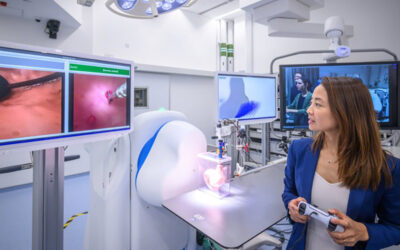Millions of people worldwide are affected by inflammatory bowel disease (IBD), a condition that causes significant discomfort and impairs quality of life. IBD is a chronic inflammatory disease of the gastrointestinal tract, with the most common forms being Crohn’s disease and ulcerative colitis.
While treatment options are limited, a group of scientists has reported in a recent article published in Small how they were able to decrease IBD symptoms in mice using an innovative therapy. The mice recovered faster from colitis than the control group, paving the way for a new and effective IBD treatment in humans.
To develop their new approach, the team based at Hanyang University in the Republic of Korea looked into the biological pathways in the development of IBD. Individuals with IBD experience a disruption in the normal functions of the intestinal barrier, which controls nutrient and water absorption while keeping out harmful substances such as bacteria and toxins from the gut.
In an inflammatory state, cells in the gut produce reactive oxygen species, like hydrogen peroxide, that cause oxidative stress, and release pro-inflammatory signaling molecules called damage-associated molecular patterns, or DAMPs, that worsen conditions. These processes create a challenging environment for the body to maintain a healthy digestive system.
Furthermore, it has been shown that people with IBD have a dysregulation of their intestinal microbiota, the diverse community of microorganisms that reside in the digestive tract. In IBD, there is a loss of composition diversity in the microbiota, leading to an increasing rate of harmful bacteria, which leads to more inflammation.
Treating IBD with Aurozyme
Given the multitude of biological factors involved, IBD is hard to treat. With the idea of addressing the principal inflammatory signals in IBD, the scientists of the current study created a synthetic enzyme or nanozyme called Aurozyme, which converts reactive oxygen species common in this disease into water and oxygen. Additionally, it was found to block DAMP signals to decrease inflammation, leading to the normalization of the gut microbiome which brings to the recovery from colitis symptoms.
“By scavenging multiple danger signals in colitis, Aurozyme aids in the restoration of the damaged intestinal barrier function, thereby promoting the balance of the gut microbiome and facilitating the proliferation of beneficial bacteria that contribute to the recovery process in colitis patients,” said Dong Yun Lee, professor in the Department of Bioengineering at Hanyang University and lead author of the study.
To remove reactive oxygen species from the inflamed tissues, Lee and the team used gold nanoparticles, which are known to consume hydrogen peroxide, one of the principal oxidative molecules produced during IBD. But a problem is that once gold nanoparticles are ingested, they don’t linger long enough in the gastrointestinal tract to have the intended therapeutic effect because they have the same charge on their surface as the cells in the internal intestinal wall, leading them to repel each other.
To overcome this, the scientists coated them with a substance called glycol chitosan whose chemical properties make it “stick” to the internal mucus layer of the gut. “Initially, our expectations were focused on utilizing the peroxidase-like activity of gold nanoparticles in the treatment of colitis,” said Lee. “However, through our research, we made a remarkable discovery: the glycol chitosan coating layer surrounding the gold nanoparticles created an amine-rich environment that transformed their peroxidase-like activity into a highly beneficial catalase-like activity.”
Both, peroxidase and catalase enzymes naturally consume hydrogen peroxide, but the byproducts of their reactions differ. While peroxidases produce hydroxyl radicals after they break down hydrogen peroxide — which can themselves be damaging to living cells — catalases produce water and oxygen. “This catalase-like activity [of our nanoparticles] played a crucial role in reducing inflammation and promoting tissue repair, exceeding our initial expectations,” Lee added. “The ability of Aurozyme to switch its enzymatic behavior and combat detrimental factors in colitis represents a breakthrough in the field of nanomedicine and offers promising possibilities for treating the condition.”
The team wanted to further improve their nanozyme to allow it to address other aspects of IBD, such as inhibiting a particular DAMP called HMGB1 to help rescue the inflammatory state of the gut. To do this, in addition to the glycol chitosan, they added an extra coating that contained a molecule called glycyrrhizin.
This compound is found in licorice root, and is known to bind with high affinity to HMGB1, thus hopefully shutting down its pro-inflammatory effects in the intestine when used in the nanozyme therapy. “By conjugating glycyrrhizin to the glycol chitosan coating layer, Aurozyme gains the ability to effectively scavenge HMGB1, further enhancing its therapeutic potential in treating colitis,” said Lee.
Nanozymes in the clinic
Aurozyme, or any other type of nanozyme therapy, have not yet been tested outside of animal models. However, several clinical trials evaluating the safety and efficacy of gold nanoparticles as general drug carriers have proven their safety in humans. “One example is ‘NU-0129 in Treating Patients With Recurrent Glioblastoma or Gliosarcoma Undergoing Surgery’ (ClinicalTrials.gov Identifier: NCT03020017), which is a first-in-human trial to determine the safety of NU-0129 consisting of nucleic acids arranged on the surface of small spherical gold nanoparticle,” said Lee.
Before stepping into human tests, more preclinical studies in animal models of colitis are needed to evaluate Aurozyme’s optimal dosages, potential side effects, and its efficacy as a long-term therapy, since IBD is a chronic condition.
“Comprehensive toxicology studies are needed to evaluate safety, and rigorous efficacy studies are needed to confirm therapeutic benefits,” said Lee. “In addition, large-scale manufacturing process development of samples for clinical research is also required.”
“If practical solutions are developed, nanozymes could soon be applied to the human body in the near future,” he added.
Reference: Hyung Shik Kim, et al. Aurozyme: A Revolutionary Nanozyme in Colitis, Switching Peroxidase-Like to Catalase-Like Activity, Small (2023). DOI: 10.1002/smll.202302331
Feature image credit: Pawel Czerwinski on Unsplash

















